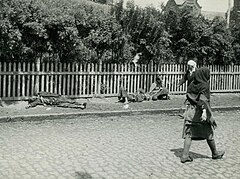man-made famine in Soviet Ukraine from 1932 to 1933 that killed millions of Ukrainians From Wikipedia, the free encyclopedia
The Holodomor (Ukrainian: Голодомор, "murder by hunger") was a man-made famine[2] that happened in Ukraine in 1932 and in 1933. It is also known as the Terror-Famine or Great Famine. At that time, Ukraine was a part of the Soviet Union. Around 7,000,000 people were starved to death under the policies of Joseph Stalin.[2][3]
| Holodomor Голодомор | |
|---|---|
 Starved peasants on a street in Kharkiv, 1933 | |
| Country | Soviet Union |
| Location | Central and Eastern Ukraine |
| Period | 1932–1933 |
| Total deaths | 7.5 million - 13 million. |
| Observations |
|
| Relief | Foreign relief rejected by the Soviet state under Joseph Stalin. Respectively 176,200 and 325,000 tons of grains provided by the Soviet state as food and seed aids between February and July 1933.[1] |
Joseph Stalin was the leader and dictator of the Soviet Union, which was a communist country. He made farmers in the Soviet Union change the way they farmed; then he tried to make the farmers work harder for the government-owned farms, for less money.[4] Many people in Ukraine did not want to go along with this.
When Ukraine had a famine, Stalin refused to help the people there. Instead, the government took food away from people. It became illegal (against the law) to pick up food from the ground of fields.[5] The government also tried to stop people from moving around the country to look for food.
Scholars and politicians using the word Holodomor say the famine was a genocide because it was man-made.[6] Some compare it to the Holocaust because millions of people died.[6] They argue that the Soviet policies were an attack on the rise of Ukrainian nationalism and therefore is a genocide.[7][8][9][10][11]

Other scholars say that the Holodomor was an unexpected consequence of the rapid and massive industrialization started by Stalin, which brought radical economic changes to the farmers and the country, and which was not done on purpose.[9][12][13]
Since the 1930s, many Western scholars have denied the Holodomor for different reasons, mainly out of communist sympathy, preventing them from acknowledging the Holodomor and the worth of Ukrainians as human beings. Such denial is deemed essentially racist and dehumanizing.[14][15]
Walter Duranty, a Moscow-based New York Times journalist in the 1930s, wrote a series of articles denying the Holodomor and praising Joseph Stalin, while millions of Ukrainians starved to death. The articles ironically won Duranty the 1932 Pulitzer Prize, which caused on-and-off controversy in the following decades. In 2003, the New York Times and Pulitzer Prize board reviewed Duranty's articles separately, yet declined to withdraw his prize.[16][17]
Oksana Piaseckyj, a Ukrainian-American activist who fled to the United States as a child in 1950, referred to Walter Duranty as "the personification of evil in journalism."[18] This case has become the biggest scandal in the history of the New York Times.[19]
| List of countries which officially recognize the Holodomor as genocide | ||
|---|---|---|
|
| ||
Seamless Wikipedia browsing. On steroids.
Every time you click a link to Wikipedia, Wiktionary or Wikiquote in your browser's search results, it will show the modern Wikiwand interface.
Wikiwand extension is a five stars, simple, with minimum permission required to keep your browsing private, safe and transparent.